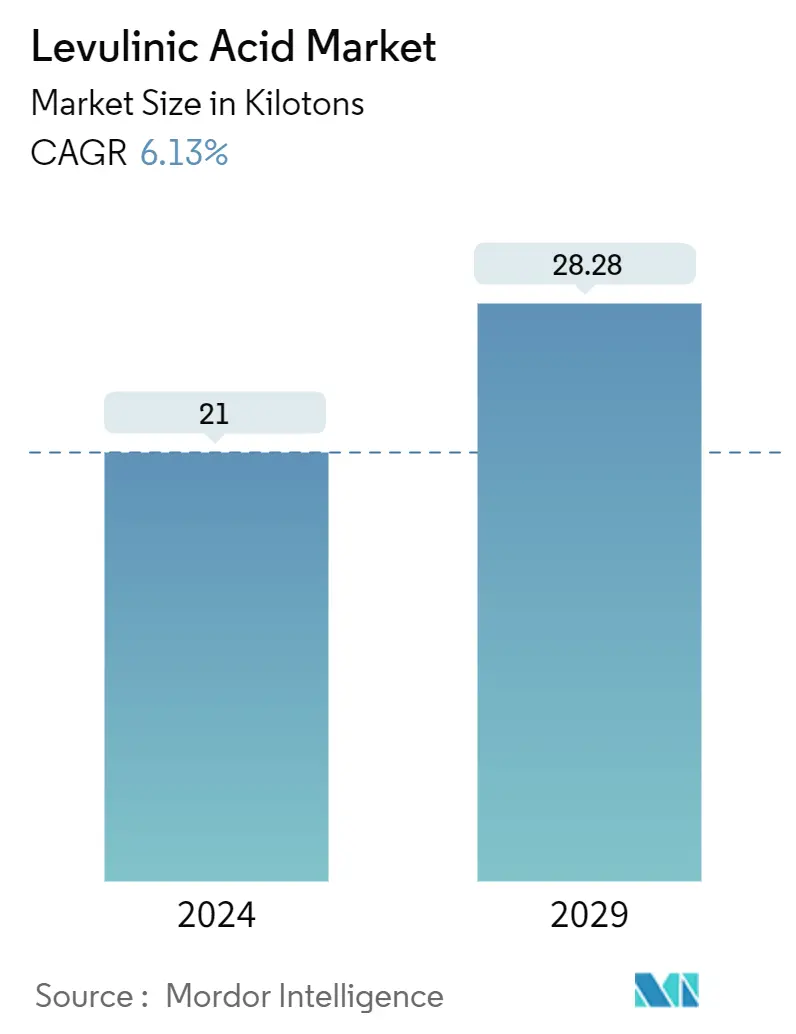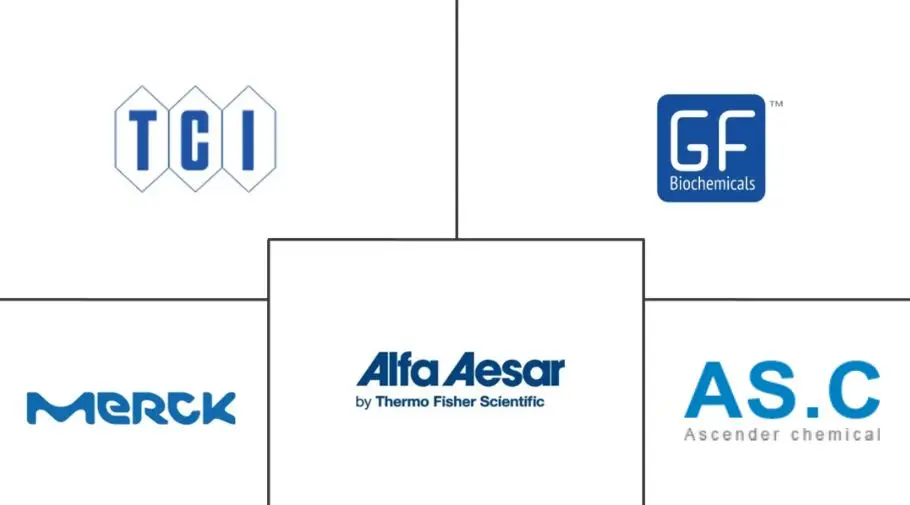Market Size of Levulinic Acid Industry

| Study Period | 2019-2029 |
| Base Year For Estimation | 2023 |
| CAGR (2024 - 2029) | 6.13 % |
| Fastest Growing Market | Asia Pacific |
| Largest Market | Asia Pacific |
| Market Concentration | High |
Major Players
*Disclaimer: Major Players sorted in no particular order |
Levulinic Acid Market Analysis
The Levulinic Acid Market size is estimated at 21 kilotons in 2024, and is expected to reach 28.28 kilotons by 2029, growing at a CAGR of 6.13% during the forecast period (2024-2029).
Due to COVID-19, production in various chemical and other industries decreased, and the supply of raw materials to industries was significantly affected. The unfavorable conditions arising from the pandemic resulted in the negative growth of the Levulinic Acid Market. However, the market was anticipated to retain its growth trajectory in 2022 due to the resumed production processes of all industries.
- Over the medium term, the major factor driving the market's growth studied is the increasing usage as substitutes for traditional fertilizers.
- On the flip side, the substitution from alternatives is expected to hinder the market's growth.
- The growing prevalence of bio-based levulinic acid is an opportunity for market growth shortly.
- The Asia-Pacific region is expected to dominate the market and will likely witness the highest CAGR during the forecast period.
Levulinic Acid Industry Segmentation
Levulinic acid is a white crystalline solid soluble in water and organic solvents. It is an organic compound and is derived from cellulose degradation.
The levulinic acid market is segmented by end-user industry (Cosmetics and Personal Care, Pharmaceuticals, Agrochemicals, Polymers and Plasticizers, Fuel and Fuel Additives, Flavors and Fragrances, and Other End-user Industries) and geography (Asia-Pacific, North America, Europe, South America, and Middle-East and Africa). The report offers market size and forecasts for the market in terms of volume (Tons) for all the above segments.
| End-user Industry | |
| Cosmetics and Personal Care | |
| Pharmaceuticals | |
| Polymers and Plasticizers | |
| Fuel and Fuel Additives | |
| Flavors and Fragrances | |
| Other End-user Industries |
| Geography | |||||||
| |||||||
| |||||||
| |||||||
| |||||||
|
Levulinic Acid Market Size Summary
The Levulinic Acid Market is poised for significant growth over the forecast period, driven by its increasing application as a substitute for traditional fertilizers and its expanding use in the cosmetics and personal care industries. The market experienced a downturn due to the COVID-19 pandemic, which disrupted production and supply chains, but has since resumed its growth trajectory. The Asia-Pacific region, particularly countries like China, India, and Japan, is expected to dominate the market, benefiting from high demand in both agricultural and cosmetic sectors. The region's rapid urbanization, growing upper-middle-class population, and increasing consumer interest in premium products are further propelling market expansion.
Levulinic acid's versatility is evident in its wide range of applications, from being a key ingredient in beauty products approved by regulatory bodies like the US FDA and the European Union to its role as a bio-based alternative in various industrial processes. The market is also witnessing opportunities through the development of bio-based levulinic acid, which aligns with global sustainability trends. However, the market faces challenges from alternative substitutes that could impede growth. The presence of major players such as GFBiochemicals Ltd and Merck KGaA, along with strategic partnerships and product launches, is expected to shape the competitive landscape and drive innovation in the market.
Levulinic Acid Market Size - Table of Contents
-
1. MARKET DYNAMICS
-
1.1 Drivers
-
1.1.1 Increasing Usage as a Substitute for Traditional Fertilizer
-
1.1.2 Other Drivers
-
-
1.2 Restraints
-
1.2.1 Unfavorable Conditions Arising Due to the COVID-19 Impact
-
-
1.3 Industry Value Chain Analysis
-
1.4 Porter's Five Forces Analysis
-
1.4.1 Bargaining Power of Suppliers
-
1.4.2 Bargaining Power of Consumers
-
1.4.3 Threat of New Entrants
-
1.4.4 Threat of Substitute Products and Services
-
1.4.5 Degree of Competition
-
-
-
2. MARKET SEGMENTATION (Market Size in Volume)
-
2.1 End-user Industry
-
2.1.1 Cosmetics and Personal Care
-
2.1.2 Pharmaceuticals
-
2.1.3 Polymers and Plasticizers
-
2.1.4 Fuel and Fuel Additives
-
2.1.5 Flavors and Fragrances
-
2.1.6 Other End-user Industries
-
-
2.2 Geography
-
2.2.1 Asia-Pacific
-
2.2.1.1 China
-
2.2.1.2 India
-
2.2.1.3 Japan
-
2.2.1.4 South Korea
-
2.2.1.5 Rest of Asia-Pacific
-
-
2.2.2 North America
-
2.2.2.1 United States
-
2.2.2.2 Canada
-
2.2.2.3 Mexico
-
-
2.2.3 Europe
-
2.2.3.1 Germany
-
2.2.3.2 United Kingdom
-
2.2.3.3 France
-
2.2.3.4 Italy
-
2.2.3.5 Rest of Europe
-
-
2.2.4 South America
-
2.2.4.1 Brazil
-
2.2.4.2 Argentina
-
2.2.4.3 Rest of South America
-
-
2.2.5 Middle-East and Africa
-
2.2.5.1 Saudi Arabia
-
2.2.5.2 South Africa
-
2.2.5.3 Rest of Middle-East and Africa
-
-
-
Levulinic Acid Market Size FAQs
How big is the Levulinic Acid Market?
The Levulinic Acid Market size is expected to reach 21 kilotons in 2024 and grow at a CAGR of 6.13% to reach 28.28 kilotons by 2029.
What is the current Levulinic Acid Market size?
In 2024, the Levulinic Acid Market size is expected to reach 21 kilotons.

